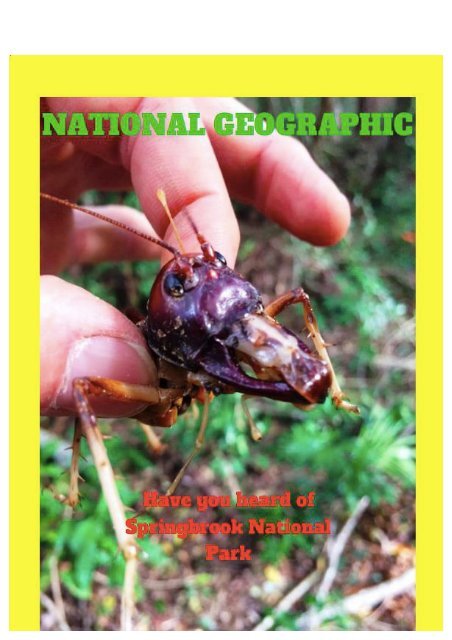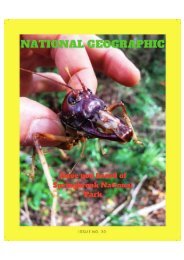Background Info
You also want an ePaper? Increase the reach of your titles
YUMPU automatically turns print PDFs into web optimized ePapers that Google loves.
<strong>Background</strong> <strong>Info</strong>: Springbrook National Park is listed as a world heritage site as it is a<br />
remanet of the north side of a volcano shield that was believed to dominate around 23<br />
million years ago. The shield rapped around all of the Tweed Valley with Mt Warning being<br />
the centre. On the December of 1994 UNESCO (World Heritage Committee) Committee<br />
officially declared that the Gondwana Rainforest this area includes places like Lamington<br />
and Springbrook National Parks and the main parts of Mt Barneys range. In the past 200<br />
years 3 quarters of all Australian rainforests have been destroyed. However, the Gondwana<br />
region has continued to survive and will for many years to come as it is home to over 1700<br />
different types of flowering plants and over 500 different vertebrate animals.<br />
The Undisturbed and The Disturbed Site: On the day of the testing, the results were<br />
recorded in two different places (An undisturbed site and a disturbed site) to compare<br />
between the different areas of the Mt Cougal area the first being an undisturbed site off track<br />
from the normal route and the second being a disturbed site with human impacts<br />
Undisturbed site<br />
At the undisturbed site, there was a small stream running with large rocks no canopy cover<br />
over the stream and dense forest surrounding the area and abundance of small seedlings and<br />
saplings. The time taken to conduct the measurements was 50 minutes, there was a total of 25<br />
seedlings and 17 saplings with leaf litter just under half of the quadrat. The three trees in the<br />
4 metre by 4 metre square quadrat were 2.31 metres, 2.12 metres and 3.08 metres with an<br />
average height of 2.5 metres tall. The average air temperature was 17.1° C, the average<br />
ground temperature was 14.04° C and the soil pH was 5.7. At this site, the average light<br />
intensity 602.1 LUX, an average 70% canopy cover and an average of 42.50% ground cover.<br />
The human impacts found in the area were beer bottles, thongs, plastic wrappers and pink<br />
plastic markers on trees. The abiotic factors in the include soil, water, rocks, temperature and<br />
humidity.<br />
Disturbed site<br />
The disturbed site consists of an open area with no canopy surrounding an abandon drilling<br />
station with tall trees and closed canopy to the side with few seedlings and saplings. There<br />
was a total of 15 seedlings and 12 saplings with leaf litter covering just of half of the quadrat.
The three trees between the quadrat had a height of 2.46 metres, 3.36 metres and 6.51 metres<br />
with an average height of 4.11. In this area, the average air temperature was 16.7° C, the<br />
average ground temperature was 15.7 and with a soil pH of 6. The area had an average light<br />
intensity of 1347.40 LUX, an average of 75% canopy cover and an average ground cover of<br />
55% At the disturbed area the human impacts included: a concrete pathway, a wooden fence<br />
plastic wrappers and an abandon drilling station. The abiotic factors for this area were soil,<br />
temperature and humidity<br />
Comparison<br />
The difference in the amount of seedlings and saplings between the two areas vary in<br />
numbers as the second area doesn’t have people constantly walking in and out as opposed to<br />
the disturbed sit that was right next to the pathway, this makes the growth of seedlings and<br />
saplings hard as they could be trampled. The difference in the height of the trees differs due<br />
to where the quadrat was set up. The air temperature, the soil temperature and the light<br />
intensity for each site ranges due to the amount canopy cover that intern effects the amount of<br />
sunlight that reaches the soil and air unless there are any open spaces allowing sunlight to<br />
reach those areas in the mornings and afternoons. The average soil pH of the for both of the<br />
sites are very close together and are in the optimal growing range for plants. The canopy<br />
cover for these sites are very close with the disturbed site with just a little but denser, this is<br />
only due to where the quadrat was set up, for the other quadrats the canopy cover was not as<br />
high. The ground cover in the two sites was similar to the canopy cover as where it was<br />
placed was where all of the ground cover had fallen onto the pathway and had been swept up<br />
onto our area, this creates a human impact as there would not usually be as much ground<br />
cover in just one area.<br />
Conclusion<br />
This report shows the difference between a disturbed site an undisturbed site in the Mt<br />
Cougal area. It demonstrates how the sites differ in terms of number of seedlings and<br />
saplings, tree height, air temperature, soil temperature, soil pH, light intensity, canopy cover<br />
and ground cover. Using the listed tests, the report is able to clearly indicate the differences<br />
in the two sites.



